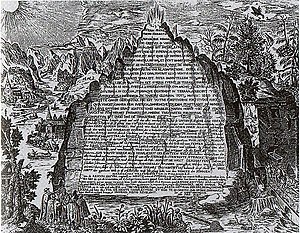
An imaginative 17th century depiction of the Emerald Tablet from the work of Heinrich Khunrath, 1606.
The Emerald Tablet, also known as the Smaragdine Table, or Tabula Smaragdina, is a compact and cryptic piece of Hermetica reputed to contain the secret of the prima materia and its transmutation. It was highly regarded by European alchemists as the foundation of their art and its Hermetic tradition. The original source of the Emerald Tablet is unknown. Although Hermes Trismegistus is the author named in the text, its first known appearance is in a book written in Arabic between the sixth and eighth centuries. The text was first translated into Latin in the twelfth century. Numerous translations, interpretations and commentaries followed.
The layers of meaning in the Emerald Tablet have been associated with the creation of the philosopher's stone, laboratory experimentation, phase transition, the alchemical magnum opus, the ancient, classical, element system, and the correspondence between macrocosm and microcosm.
Textual history
The text of the Smaragdine Tablet gives its author as Hermes Trismegistus ("Hermes the Thrice-Greatest"), a legendary Hellenistic[1] combination of the Greek god Hermes and the Egyptian god Thoth.[2] Despite the claims of antiquity, it's believed to be an Arabic work written between the sixth and eighth centuries.[3] The oldest documentable source of the text is the Kitāb sirr al-ḫalīqa (Book of the Secret of Creation and the Art of Nature), itself a composite of earlier works. This volume is attributed to "Balinas" (or Pseudo-Apollonius of Tyana) who wrote sometime around the eighth century.[4] In his book, Balinas frames the Emerald Tablet as ancient Hermetic wisdom. He tells his readers that he discovered the text in a vault below a statue of Hermes in Tyana, and that, inside the vault, an old corpse on a golden throne held the emerald tablet.[5]
Following Balinas, an early version of the Emerald Tablet appeared in Kitab Ustuqus al-Uss al-Thani (Second Book of the Elements of Foundation) attributed to Jabir ibn Hayyan.[6] The Smaragdine Tablet was first translated into Latin in the twelfth century by Hugo von Santalla.[7] The text is also in an enlarged thirteenth century edition of Secretum Secretorum
هیچ نظری موجود نیست:
ارسال یک نظر